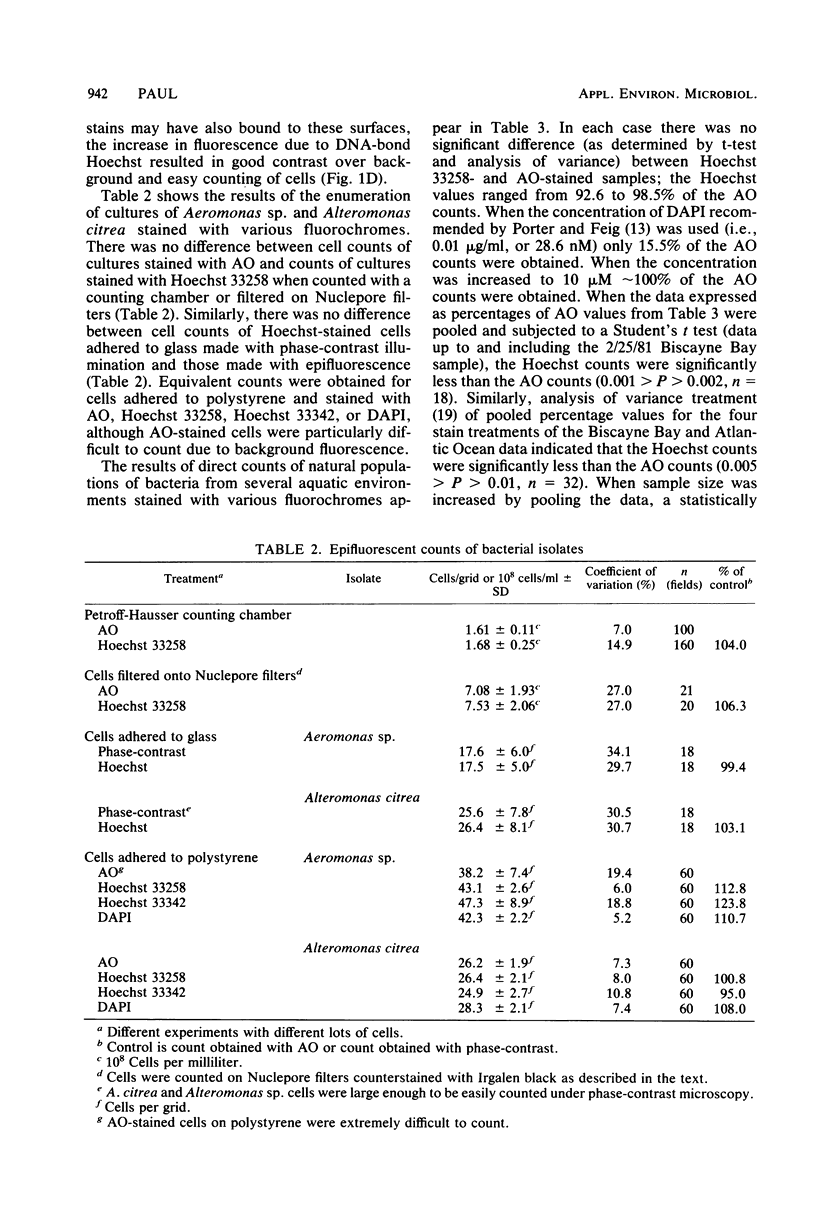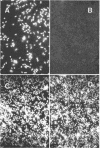Abstract
The DNA-specific fluorochromes Hoechst 33258 and 33342 were used to enumerate aquatic bacteria by epifluorescent direct counts. Cultures of estuarine bacteria gave identical counts when stained with Hoechst 33258 or acridine orange, whereas natural populations of aquatic bacteria gave 92 to 98.5% of the acridine orange counts. The technique had distinct advantages over acridine orange when enumerating bacteria on surfaces which bind acridine orange, such as polystyrene.
Full text
PDF





Images in this article
Selected References
These references are in PubMed. This may not be the complete list of references from this article.
- Allan R. A., Miller J. J. Influence of S-adenosylmethionine on DAPI-induced fluorescence of polyphosphate in the yeast vacuole. Can J Microbiol. 1980 Aug;26(8):912–920. doi: 10.1139/m80-158. [DOI] [PubMed] [Google Scholar]
- Cesarone C. F., Bolognesi C., Santi L. Improved microfluorometric DNA determination in biological material using 33258 Hoechst. Anal Biochem. 1979 Nov 15;100(1):188–197. doi: 10.1016/0003-2697(79)90131-3. [DOI] [PubMed] [Google Scholar]
- Diakun G. P., Edwards H. E., Allen J. C., Phillips G. O. Analysis of glycosaminoglycans in urine by using acridine orange fluorescence. Biochem J. 1978 Nov 1;175(2):573–577. doi: 10.1042/bj1750573. [DOI] [PMC free article] [PubMed] [Google Scholar]
- Francisco D. E., Mah R. A., Rabin A. C. Acridine orange-epifluorescence technique for counting bacteria in natural waters. Trans Am Microsc Soc. 1973 Jul;92(3):416–421. [PubMed] [Google Scholar]
- Fried J., Yataganas X., Kitahara T., Perez A., Ferguson R., Sullivan S., Clarkson B. Quantitative analysis of flow microfluorometric data from asynchronous and drug-treated cell populations. Comput Biomed Res. 1976 Jun;9(3):277–290. doi: 10.1016/0010-4809(76)90007-0. [DOI] [PubMed] [Google Scholar]
- Gray J. W., Coffino P. Cell cycle analysis by flow cytometry. Methods Enzymol. 1979;58:233–248. doi: 10.1016/s0076-6879(79)58140-3. [DOI] [PubMed] [Google Scholar]
- Hobbie J. E., Daley R. J., Jasper S. Use of nuclepore filters for counting bacteria by fluorescence microscopy. Appl Environ Microbiol. 1977 May;33(5):1225–1228. doi: 10.1128/aem.33.5.1225-1228.1977. [DOI] [PMC free article] [PubMed] [Google Scholar]
- Jarnagin J. L., Luchsinger D. W. The use of fluorescein diacetate and ethidium bromide as a stain for evaluating viability of mycobacteria. Stain Technol. 1980 Jul;55(4):253–258. doi: 10.3109/10520298009067249. [DOI] [PubMed] [Google Scholar]
- Krishan A., Ganapathi R. N., Israel M. Effect of adriamycin and analogs on the nuclear fluorescence of propidium iodide-stained cells. Cancer Res. 1978 Nov;38(11 Pt 1):3656–3662. [PubMed] [Google Scholar]
- Latt S. A., Stetten G. Spectral studies on 33258 Hoechst and related bisbenzimidazole dyes useful for fluorescent detection of deoxyribonucleic acid synthesis. J Histochem Cytochem. 1976 Jan;24(1):24–33. doi: 10.1177/24.1.943439. [DOI] [PubMed] [Google Scholar]
- Massari S., Pascolini D., Gradenigo G. Distribution of negative phospholipids in mixed vesicles. Biochemistry. 1978 Oct 17;17(21):4465–4469. doi: 10.1021/bi00614a016. [DOI] [PubMed] [Google Scholar]
- SAUNDERS A. M. HISTOCHEMICAL IDENTIFICATION OF ACID MUCOPOLYSACCHARIDES WITH ACRIDINE ORANGE. J Histochem Cytochem. 1964 Mar;12:164–170. doi: 10.1177/12.3.164. [DOI] [PubMed] [Google Scholar]
- Timár J., Gyapay G., Lapis K. Acridine orange staining of the mammalian fibroblast cell coat. Histochemistry. 1979 Nov;64(2):189–193. doi: 10.1007/BF00490098. [DOI] [PubMed] [Google Scholar]
- Watson S. W., Novitsky T. J., Quinby H. L., Valois F. W. Determination of bacterial number and biomass in the marine environment. Appl Environ Microbiol. 1977 Apr;33(4):940–946. doi: 10.1128/aem.33.4.940-946.1977. [DOI] [PMC free article] [PubMed] [Google Scholar]
- van Rooijen N., van Nieuwmegen R. Fluorochrome staining of multilamellar liposomes. Stain Technol. 1978 Nov;53(6):307–310. doi: 10.3109/10520297809111951. [DOI] [PubMed] [Google Scholar]



